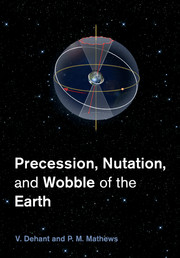Book contents
- Frontmatter
- Contents
- Preface
- List of abbreviations
- 1 Introduction – Fundamental definitions – Motivation
- 2 Concepts and elementary theory
- 3 Reference systems and frames
- 4 Observational techniques – ephemerides
- 5 Rigid Earth precession and nutation
- 6 Deformable Earth – Love numbers
- 7 Nutations of a non-rigid Earth
- 8 Anelasticity
- 9 Ocean and atmospheric corrections
- 10 Refinements of non-rigid nutation
- 11 Comparison observation-theory
- 12 Conventions
- 13 Mars nutations
- Appendix A Rotation representation
- Appendix B Clairaut theory
- Appendix C Definitions of equinoxes
- Bibliography
- Index
4 - Observational techniques – ephemerides
Published online by Cambridge University Press: 05 May 2015
- Frontmatter
- Contents
- Preface
- List of abbreviations
- 1 Introduction – Fundamental definitions – Motivation
- 2 Concepts and elementary theory
- 3 Reference systems and frames
- 4 Observational techniques – ephemerides
- 5 Rigid Earth precession and nutation
- 6 Deformable Earth – Love numbers
- 7 Nutations of a non-rigid Earth
- 8 Anelasticity
- 9 Ocean and atmospheric corrections
- 10 Refinements of non-rigid nutation
- 11 Comparison observation-theory
- 12 Conventions
- 13 Mars nutations
- Appendix A Rotation representation
- Appendix B Clairaut theory
- Appendix C Definitions of equinoxes
- Bibliography
- Index
Summary
The angles representing the orientation of the Earth in space are determined, as functions of time, primarily through very long baseline interferometry (VLBI). The temporal variations of these angles are characterized by the terms precession, nutation, and length-of-day (LOD) variations. However global positioning system (GPS) or more generally global navigation satellite system (GNSS) observations have also shown the capability to give useful results for the shorter period nutations, besides LOD variations.
VLBI
The purpose of this section is not to provide all the detail on the VLBI principle, measurements, and processing and certainly not to provide all the mathematical details. The reader may refer to textbooks including tutorials such as Thompson et al. (1986), Felli and Spencer (1989), or Zensus and Napier (1995) for further details.
Principle of observation
This geodetic technique is based on simultaneous recordings of radio emissions received from extragalactic radio sources by a number of large radio telescopes (6 to 16) from which the source is “visible” at the time of observation. Emissions from a radio source arise from the time variable electromagnetic fields over its surface. Electromagnetic waves radiate away from the source in accordance with Maxwell's equations. On arrival at the VLBI stations on the Earth, the radiations within a certain range of frequencies (e.g. in the X-band around 8.4 GHz) are recorded by the VLBI antennas and associated devices with the aid of band-pass filters.
A VLBI network consists of a number of large radio dish antennas, ranging from 3 to 100 meters in diameter, distributed all over the globe, located at distances of hundreds to thousands of kilometers from one another. Electromagnetic waves from a radio source, so far away from the Sun that any motion it has in space is practically undetectable from the Earth, are received and recorded as functions of the time of arrival, at each of a subset of radio antennas in the VLBI network from which the source is simultaneously visible at the time of observation.
- Type
- Chapter
- Information
- Precession, Nutation and Wobble of the Earth , pp. 96 - 120Publisher: Cambridge University PressPrint publication year: 2015



